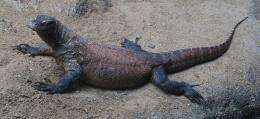Komodo even more deadly than thought: Research

The carnivorous reptiles (Varanus komodoensis) are known to bite prey and release them, leaving them to bleed to death from their wounds: the victims are reported to go into shock before the dragons kill and eat them.
Some researchers believe that prey are killed by pathogenic bacteria in the dragons' mouths but the new research - published in the latest issue of Proceedings of the National Academy of Sciences - shows that the combination of the reptiles' teeth and venom likely accounts for their hunting prowess.
"The view that the Komodo routinely kills using dirty oral bacteria is wrong," says research co-author, Dr Stephen Wroe from the University of New South Wales, Australia. "The dragon is truly poisonous. It has modified salivary glands that deliver both hypertensive and anti-blood-clotting agents, which, in combination with lightweight but sophisticated cranial and dental adaptations, allows it to kill large animals through rapid blood loss."
The researchers used computer modeling to analyse the Komodo dragon bite and found that dragons have much weaker bites than crocodiles of a similar size. However, magnetic resonance imaging revealed the dragons have complex venom glands as well.
After surgically excising the glands from a terminally ill dragon in a zoo, the researchers used mass spectrometry to obtain a profile of the venom, finding that the toxin was similar to that of the Gila monster and many snakes. The venom causes a severe loss in blood pressure by preventing blood clotting and widening blood vessels, thus inducing shock in a victim.
The researchers also examined fossils of the giant extinct dragon relative Varanus megalania and determined that this seven-metre-long lizard was one of the largest venomous animals to have ever lived.
A member of the goanna family with ancestors dating back more than 100 million years, the Komodo dragon is the world's largest living lizard and inhabits the central Indonesian islands of Komodo, Rinca, Flores, Gili Motang and Gili Dasami. It grows to an average length of two to three metres and weighs around 70 kilograms. The reptile's unusual size is attributed to a phenomenon known as island gigantism, since there are no other carnivorous mammals to fill the niche on the islands where they live.
The lizards are apex predators and dominate the ecosystems in which they live. Although Komodo dragons eat carrion, they also hunt and ambush prey including invertebrates, birds, and mammals.
The dragon's large size and fearsome reputation has made it a popular zoo exhibit since Western
scientists first brought it to world attention in 1910. In the wild its total population is estimated at 4,000 to 5,000. Its range has contracted due to human activities and it is listed as vulnerable by the International Union for Conservation of Nature.
Source: University of New South Wales (news : web)
















